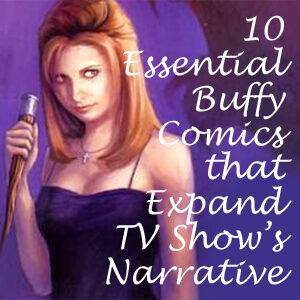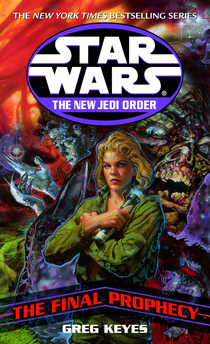“The Final Prophecy” (2003), the 18th and penultimate book of the “New Jedi Order,” is a rare “Star Wars” novel that doesn’t feature any movie characters or relations of movie characters on the cover. It’s a testament to how popular Tahiri had become that she dominates the cover art, flanked by Yuuzhan Vong shaper Nen Yim and executor/”Prophet” Nom Anor.
Greg Keyes didn’t invent Tahiri (she first appeared in the “Junior Jedi Knights” series), but he introduced her to adult readers in the “Edge of Victory” duology, so it’s appropriate that he also helps us get to know the new Tahiri in “Final Prophecy.” The new Tahiri is a merging of the old Tahiri and Riina, something that happened in her mindspace in “Force Heretic III: Reunion.” While Tahiri will go on to be a major player in “Legacy of the Force” and “Fate of the Jedi,” she’s at her high point here; it’s a shame this marks Keyes’ last “Star Wars” book.
The common ground between humans and Vong is another crucial element that Keyes brings to the “NJO.” Anakin and Vua Rapuung were the first human/Vong team-up in the saga (not counting the “Invasion” comics, which were released later), but that was a case where they had a common enemy. Tahiri and Nen Yim, on the other hand, develop a true bond, which makes sense, because half of Tahiri IS Nen Yim – “Riina’s” memories actually came from the then-junior shaper.
For several books now, various authors – through the characters – have grappled with the question of how peace can be achieved with an implacable enemy. Our heroes found the pivotal living planet Zonama Sekot in the “Force Heretic” trilogy, but we didn’t know why the planet was the key; Jacen was just following the instructions of the late, enigmatic Vergere (yet another being with connections to both the Vong and the species of the Galactic Alliance). The planet fears the Yuuzhan Vong, and the Vong populace likewise fears the planet. Supreme Overlord Shimrra executes anyone who even suggests that Zonama Sekot exists.
In “Final Prophecy,” Keyes tantalizingly hints that the Force itself originated on Zonama Sekot, and he also suggests that the planet learned from Vong biotechnology when the Far Outsiders visited in the past, as referenced in “Rogue Planet.” Although the final answers will wait until “The Unifying Force,” it seems for now that the planet has been scared of taking part in a war between its two sons, so to speak.
Keyes also serves up an intriguing conversation between Corran and Vong High Priest Harrar, with both admitting that they can see flaws in their own philosophy and truths in the others’. The Vong hate machines, permacrete and transparisteel, but they also don’t value individual sentient life. Humans (and humanoid aliens) often cut down flora and displace fauna to build cities, but they often consider individual sentient lives to be sacred.

Zonama Sekot, presenting a third way, has an ecosystem that’s always in equilibrium, as if a plan is coded in the molecules of all its life; but of course, such a thing can only happen if the planet itself is alive. Lacking that, a balance is found through the controlled chaos of survival of the fittest, and also through societal values, which can be negotiated over the course of time. The “NJO” is drifting toward the territory of having an environmental message, but it’s not off-putting, because I know a more direct tie-in to the Force is coming in the final book.
Helping to make these vague notions about civilizations’ interaction with nature more concrete, we get to see Tahiri and Corran fly in a living Sekotan ship for the first time. In “Rogue Planet,” Anakin and Obi-Wan had living ships made for them, but events conspired so they didn’t get to keep them for long. Of course, the Vong ships are also organic – although they are directly created by the Vong, rather than emerging through nature – and a living ship will also come into play in the “Lost Tribe of the Sith” and “Fate of the Jedi” sagas.
As the “NJO” shores up the crucial notion that the Jedi-worshipping Shamed Ones will help overthrow the Yuuzhan Vong from within, we also get a late-in-the-game revelation that Shimrra’s predecessor, Quoreal, did not want to invade the galaxy of the Old Republic/Empire/New Republic after what he learned about Zonama Sekot and the Force.
In the series’ final book, I’ll be hoping for a flashback of the Vong’s first encounter with Zonama Sekot and a scene set in the Vong’s intergalactic worldship caravan wherein Shimrra deposes Quoreal and announces his intention to invade “our” galaxy. Some flashbacks to Vong vs. Chiss battles in the Unknown Regions would be nice, too. Come to think of it, back in “Vector Prime,” C-3PO was able to translate Vong language because he had a similar language in his databanks, so I’d like to know what species in “our” galaxy were influenced by the Vong. In general, I’d like more details on the past connections between the two galaxies before the invasion.
Clocking in at 305 pages, “The Final Prophecy” is a brisk and purposeful story coming on the heels of the decompressed “Force Heretic” trilogy. Here, most of the pages are spent following Tahiri, Corran and their Vong fellow travelers to Zonama Sekot, and it’s surprising that we don’t check in with Luke, Jacen and company as soon as they arrive at the planet.
We also get a thread where Wedge leads a battle at Bilbringi that goes sour when the Vong knock out the HoloNet. Keyes delivers acceptable battle writing – and there’s a good side yarn where Jaina gets waylaid — but this thread pales next to Tahiri’s adventure, and I lost track of the point of the Bilbringi engagement anyway. Also, it’s odd that our heroes reinstated communications to the Unknown Regions on Esfandia in “Reunion,” and now communications are down again because of the Vong’s off-page development of drone voids that eat HoloNet relays. As such, the Esfandia mission meant nothing; it’s not the “NJO’s” tightest example of plotting.
With one book to go in the “NJO,” it’s clear that our Galactic Alliance heroes and the Shamed Ones will team up to defeat Shimrra’s forces. But there’s still a lingering mysterious element to Zonama Sekot and the precise role it will play. Rather than a smooth glide to the end, as one might’ve expected after the “Force Heretic” trilogy, some wrinkles in the narrative are brought the fore just in time for the final book.

